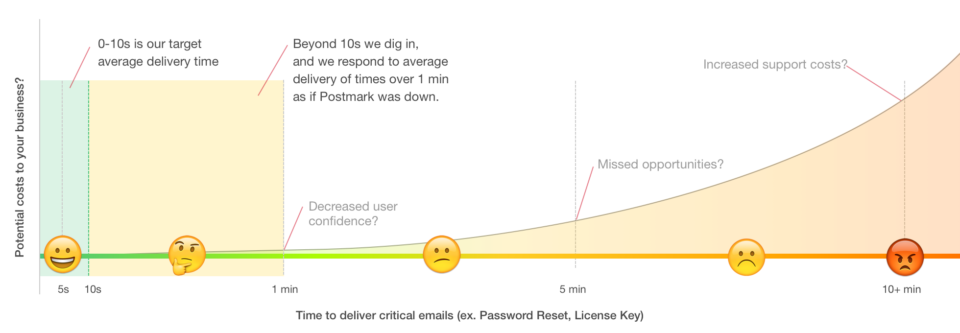How to integrate Bubble and Postmark
Are you a Bubble builder looking for a reliable way to deliver your web app’s emails? We’ve got your back. Integrate Postmark with Bubble and your emails will make it to the inbox—fast and reliably.

No matter what type of web application you’re building, it’s likely that, at some point, you’ll integrate emails into your product. Maybe you want to send an email once someone submits a form, send confirmation emails after a user created an account, or allow folks to reset their password via email.
Many of those emails can make or break a product experience: If your users aren’t receiving the email to confirm their account or can’t reset the password they’ve forgotten, they are stuck—and chances are that they get frustrated and might abandon your app.
Getting crucial application emails delivered fast and reliably is important. Here at Postmark, we help you do just that—and 100+ fellow Bubble users are loving us because of it.
We’re getting your emails delivered fast and reliably #
Postmark is an application email service that easily integrates with web applications to help you get your emails delivered, at blazing speed and with delivery rates that are way above the industry average.
That’s because we ruthlessly follow best practices for great email delivery: We only allow legitimate senders to use Postmark, have a zero-tolerance policy when it comes to spammers, and have clever systems in place to separate crucial transactional emails (like password reset emails) and marketing email (like newsletters), just as inbox providers recommend.
The result: Over the years, Postmark has build serious street cred with inbox providers so that emails sent with Postmark make it to the inbox—while those sent with other providers might not.
How to integrate Bubble with Postmark #
You’d like to use Postmark to send your Bubble emails? Welcome aboard, new friend! Let’s walk through the 3 steps you need to take to get up and running:
Step 1: set up a Postmark account #
If you don’t have a Postmark account yet, this is where we’ll get started. Head over to our sign-up page to create a free developer account.
This will let you send up to 100 emails a month for free, giving you plenty of free emails to test and experiment with Postmark. And if you’re happy and need more emails, you can upgrade to one of our paid plans at any time.
Good to know: You’ll be able to send test emails to your own domain right away, but if you’d like to send to other addresses, you need to submit your account for approval first. Why do we review each account? Because that’s how we can weed out the spammers and bad actors right away! It’s our secret to maintaining our *stellar* deliverability rates and time to inbox.
Once you’ve created your account, we’re ready to hook it up to Bubble! To make that happen, you have two options: connecting via the API connector or using a plugin.
Step 2: connect Bubble and Postmark using a pre-built plugin #
Using a pre-built plugin is the fastest way to send email with Bubble and Postmark. Currently, there are two community plugins available to help you connect with Postmark, the Rich Postmark email plugin and the Postmark Email plugin. Let’s take the first one and see how it works:
To start sending, install the plugin and add the API token of the Message Stream you’d like to use. (What are Message Streams? Message Streams and Servers help you organize email in your Postmark account. Plus, they are crucial to help separate transactional emails from marketing messages—an important step to guarantee great deliverability results.)
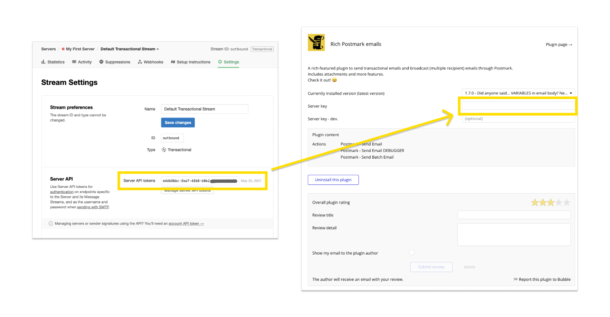
Done! Bubble is now connected to your Postmark account and you can start using the plugin’s pre-built actions to send emails via Postmark.
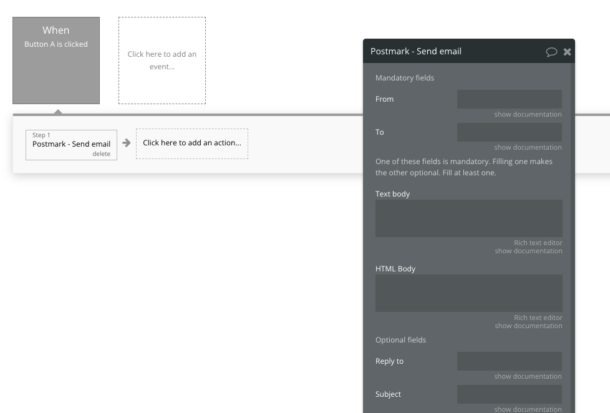
If you’re looking to send plain-text emails or simple HTML emails, this option will give you a quick and easy way to get started. The downside: Customization options are limited and as with any plugin, you’re relying on the plugin creator to keep the tool up-to-date.
Looking for something a little more advanced? Keep reading. 👇
Step 3: connect Bubble and Postmark using the API connector #
Bubble’s API connector helps you connect almost any API to Bubble and to build custom integrations that meet your needs. While the setup process is a little more involved than using a plugin, this option gives you a whole lot more flexibility.
For example, if you’re looking to use a beautiful HTML email template and dynamically update content like a user’s name, product information, or more, using data from your Bubble application, the API connector is the best way to go.
Let’s say you’d like to send a nicely designed welcome email that includes a bunch of personalized content that’s unique for each user. Postmark has some great templates you can use as a starting point:
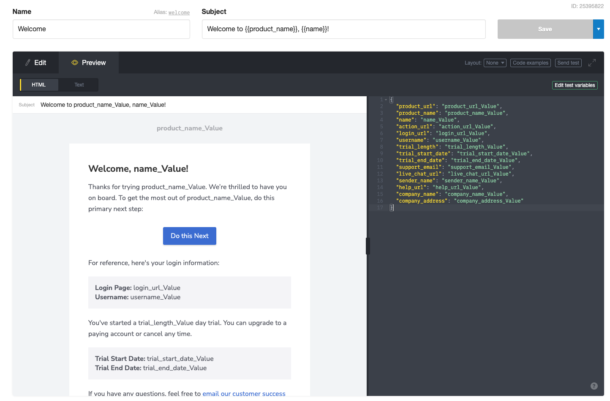
Using the API connector, you can access your Postmark account and email template of choice and specify the dynamic values that Bubble will update for each user:
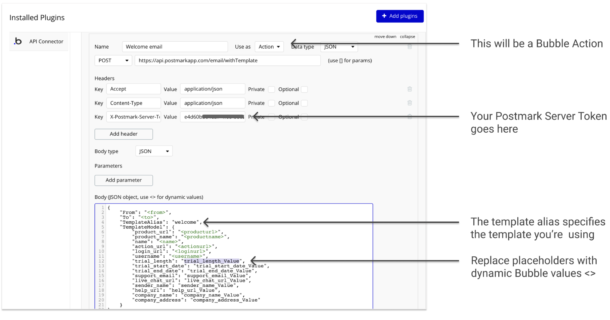
How exactly does this setup work and what information needs to go where?
Our friend James Devonport wrote an in-depth walkthrough on how to set up a welcome email with dynamic content using Bubble’s API connector where he shares every step you need to take to configure your integration. Head over to his blog to read the step-by-step guide or check out his video tutorial below. It’s fantastic.
Do you have any questions about getting started with Postmark and Bubble? We’re here to help!


